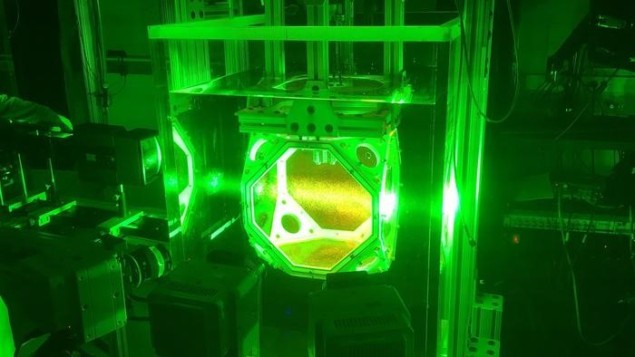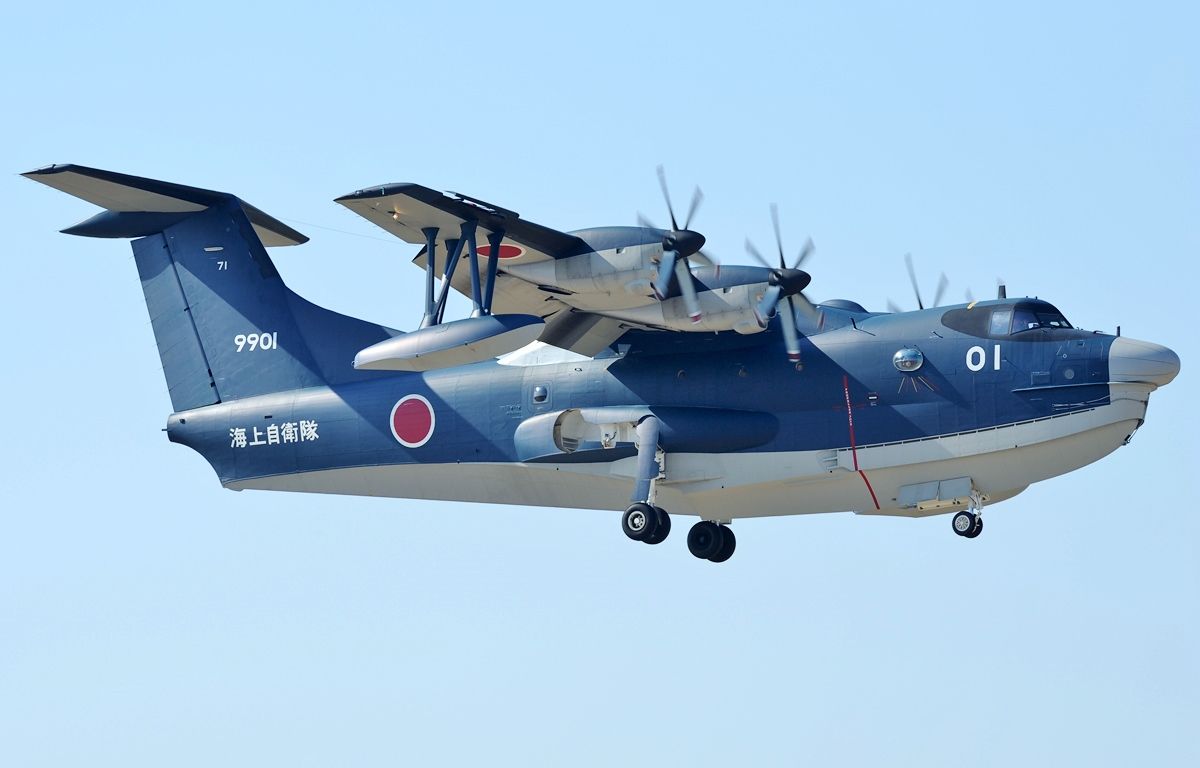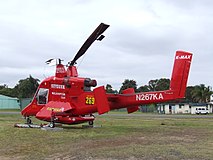Αναζήτηση αναρτήσεων
Σάββατο 29 Ιουλίου 2023
Balls of turbulence are isolated using vortex rings
Have scientists in Korea discovered the first room-temperature, ambient-pressure superconductor?
Have scientists in Korea discovered the first room-temperature, ambient-pressure superconductor?
Τετάρτη 26 Ιουλίου 2023
The ShinMaywa US-2: Japan's STOL Seaplane
The ShinMaywa US-2: Japan's STOL Seaplane
The ShinMaywa US-2 is Japan's maritime search and rescue aircraft.
While traveling by flying boat or seaplane used to be the norm before the Second World War, did you know that Japanese aircraft manufacturer ShinMaywa Industries is still building seaplanes today?
US-2 Specifications and characteristics
- Crew: 11 (two pilots, one search-and-rescue coordinator, two onboard maintenance personnel, three divers, two paramedics, and one sensor operator)
- Capacity: 20 passengers or 12 stretchers
- Length: 109 ft 9 in
- Wingspan: 108 ft 9 in
- Height: 32 ft 2 in
- Wing area: 1,462 sq ft
- Empty weight: 56,504 lb
- Gross weight: 121,581 lb
- Max takeoff weight: 105,160 lb land takeoff
- Power plant: 4 × Rolls-Royce AE 2100J turboprop, 4,592 hp each
- Propellers: 6-bladed Dowty R414
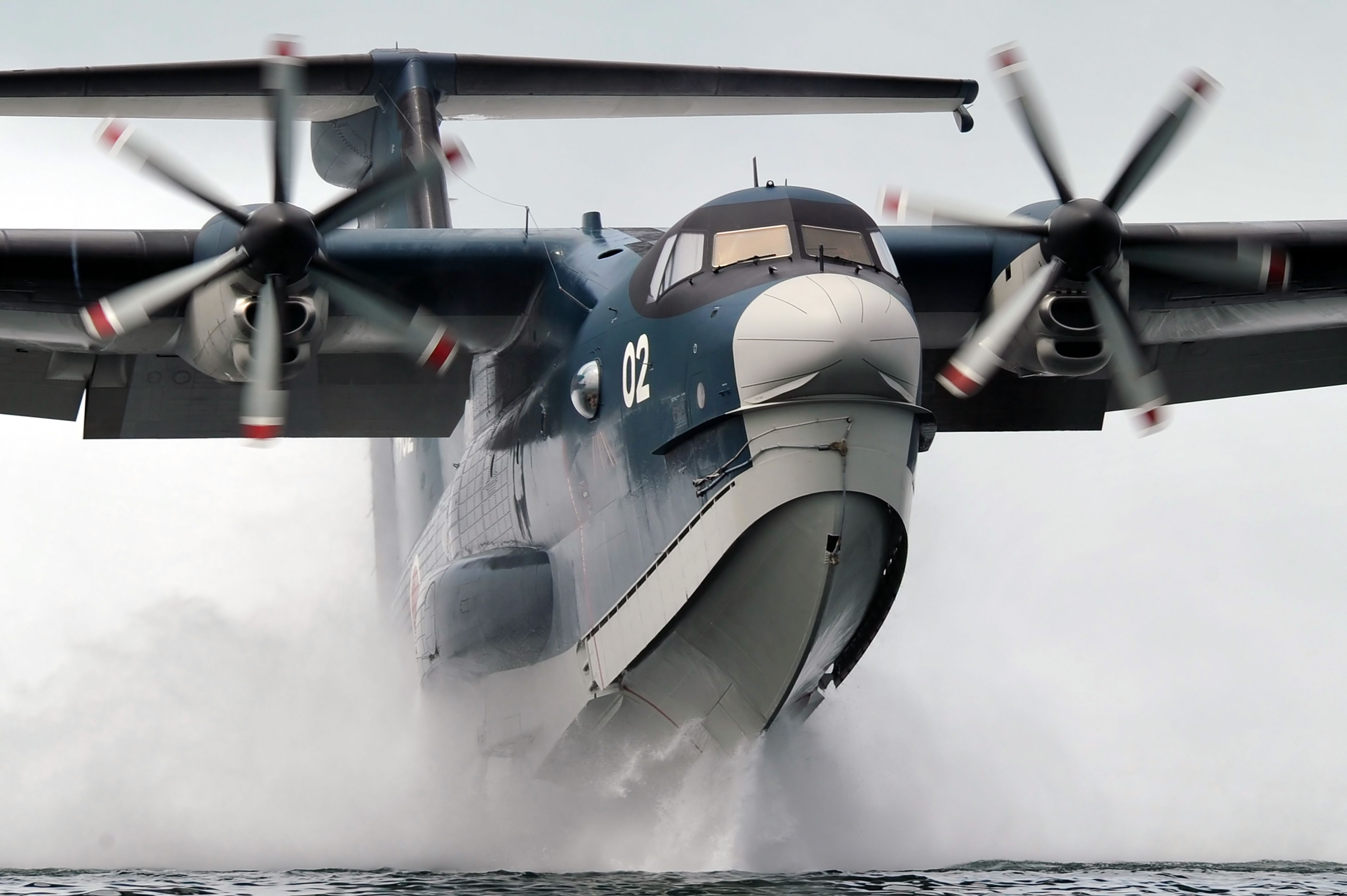
Performance
- Maximum speed: 350 mph, 300 kn
- Cruise speed: 300 mph, 260 kn at 20,000 ft
- Stall speed: 56 mph, 49 kn
- Range: 2,900 mi, 2,300 nmi
- Service ceiling: 23,606 ft
- Takeoff distance on ground: 1,610 ft at MTOW
- Landing distance on ground: 4,900 ft at MTOW
- Takeoff distance on water: 920 ft at Loaded weight
- Landing distance on water: 1,080 ft at Loaded weight
Export opportunities
Given the aircraft's all-around usefulness, it is not surprising that other countries are interested in either purchasing the US-2 or manufacturing the plane under license. The Indian Navy and Coast Guard would like to have the aircraft assembled in India as they believe it would reduce the cost by 25%.
Given the concerns many nations have with China's military growth in the South China Sea, Indonesia is seen as a potential buyer. Thailand is also looking to bolster its maritime patrol aircraft capabilities while at the same time increasing defense ties between it and Japan.
As for the firefighting version of the plane, Greece is looking into the potential of the US-2 to replace its aging Canadair-Bombardier planes.
Due to its limited production capacity, ShinMaywa would have a hard time building the US-2 for anyone other than the JMSDF, so allowing the plane to be made in another country under license would be a good idea.
FIGHTING FIRES FROM THE SKY
FIGHTING FIRES FROM THE SKY
Turn on the news today and you’re sure to hear about the massive wildfires out west. The immense acreage of forests being consumed by flames is devastating. How these fires started is of little importance right now. Containing and extinguishing them is top priority.
Aerial Firefighting

While crews on foot work endlessly to combat the wildfires, much needed support is being provided from up above. Thanks to crop-dusting technology that evolved in the 1990’s, planes and helicopters can be used to help battle the fires.
Specially equipped with large tanks, these aircraft drop thousands of gallons of water or fire retardant to reduce the spread of the fire. This, in turn, allows the firefighters to continue their efforts to get the fire under control.
Surprisingly, the primary goal of aerial firefighting is not to extinguish the fire, but rather, provide invaluable support to the ground team. In many cases, it is simply too hot and dangerous for those facing the flames to continue their work in areas without the assistance of the aerial firefighters.
The Fleet
The three main types of aircraft used in aerial firefighting are tactical planes, air tankers and helicopters. Each has their own designated role but working together they form one impressive and indispensable unit.

Tactical Planes
Twin Commander 500 and 600 are the most commonly used air tactical planes. They can stay airborne for hours and serve as the eyes in the sky for the team on the ground.
Air attack planes ensure safe aviation operations through constant communication with other aircraft. If needed, they can also act as lead planes to guide large tankers to their designated drop zones.
Air Tankers
Single Engine Air Tankers (SEATs) are small airplanes such as the Air Tractor AT-802 that has the capacity to carry up to 800 gallons. SEATs can reload and operate in areas where larger air tankers cannot.

Large Air Tankers (LATs) can carry 2,000-4,000 gallons of water or fire retardant. These include aircrafts such as the P2V, HC-130H, RJ85 and C-130.
Very Large Air Tankers (VLATs) can carry much larger loads – up to 12,000 gallons. A single load dropped by a VLAT is equivalent to roughly three loads dropped by a LAT.
DC-10 Tanker
The second largest firefighting air tanker currently in use is the DC-10. With three jet engines, it can travel much faster than other air tankers. It holds up to 12,000 gallons of water or fire retardant in its exterior belly-mounted tank. Its entire contents can be released in a mere eight seconds.
747 Supertanker
What was once an easily recognized passenger jetliner has become the world’s largest firefighting aircraft. To accomplish this, the Boeing 747 Supertanker’s interior was retrofitted with enormous tanks that stow roughly 19,000 gallons.

The aircraft has a special pressurized system that allows the water or fire retardant to be sprayed out of the aircraft with force. It can also drop its load all at once, thus falling to the ground like heavy rain.
To refill this jumbo tanker on the ground, it takes roughly 30 minutes. This is certainly a longer time than with others, but the total volume that can be dropped in one run is significantly more effective.
Air tanker loads are not usually dropped directly on the fire. But rather, they are released in front of it in an attempt to direct its course or slow its advance. Ideally, this gives the ground team the opportunity to control or extinguish the fire.
Regardless of its size, air tankers must make incredibly low flights – no higher than 200 feet above the treetops to be effective. Low flights such as these are difficult and extremely dangerous.
Water Scoopers
Whereas air tankers receive their liquid cargo while on the ground, amphibious aircraft such the Air Tractor Fire Boss and the Bombardier CL-415 skim the surface of a lake or bay to load their onboard tanks. These “Super Scooper” planes then release the water above the fire and repeat the process until refueling is needed.
They can store up to 1,500 gallons of water at a time and it takes only a mere 12 seconds to fill their tanks.

Helicopters
For fast initial attacks on small wildfires, helicopters such as the Bell 204 and Boeing Vertol 107 are put to work. They can carry about 320 gallons of water, usually in buckets that hang below the aircraft.
In addition to fire control, helicopters are used to transport equipment as well as helitack teams (wildland firefighters transported by helicopter) to the field.
Back in NW Ohio
Wildfires are certainly not common here in Ohio. And while we have not had the pleasure of welcoming an aerial firefighter on our ramp, our full service FBO is open 24/7/365.
If your travels bring you to KTOL, know that we are here with an extensive list of aircraft and passenger services available. Visit us online or give us a call at 1-800-70-GRAND.
Aerial firefighting
Aerial firefighting


Aerial firefighting, also known as waterbombing, is the use of aircraft and other aerial resources to combat wildfires. The types of aircraft used include fixed-wing aircraft and helicopters. Smokejumpers and rappellers are also classified as aerial firefighters, delivered to the fire by parachute from a variety of fixed-wing aircraft, or rappelling from helicopters. Chemicals used to fight fires may include water, water enhancers such as foams and gels, and specially formulated fire retardants such as Phos-Chek.[1]
Terminology[edit]
The idea of fighting forest fires from the air dates back at least as far as Friedrich Karl von Koenig-Warthausen's observations on seeing a blaze when overflying the Santa Lucia Range, California, in 1929.[2]: 142
A wide variety of terminology has been used in the popular media for the aircraft (and methods) used in aerial firefighting. The terms airtanker or air tanker generally refer to fixed-wing aircraft based in the United States; "airtanker" is used in official documentation.[3] The term "waterbomber" is used in some Canadian government documents for the same class of vehicles,[4][5] though it sometimes has a connotation of amphibians.[6]
Air attack is an industry term used for the actual application of aerial resources, both fixed-wing and rotorcraft, on a fire. Within the industry, though, "air attack" may also refer to the supervisor in the air (usually in a fixed-wing aircraft) who supervises the process of attacking the wildfire from the air, including fixed-wing airtankers, helicopters, and any other aviation resources assigned to the fire. The Air Tactical Group Supervisor (ATGS), often called "air attack", is usually flying at an altitude above other resources assigned to the fire, often in a fixed-wing plane but occasionally (depending on assigned resources or the availability of qualified personnel) in a helicopter.
Depending on the size, location, and assessed potential of the wildfire, the "air attack" or ATGS person may be charged with initial attack (the first response of firefighting assets on fire suppression), or with extended attack, the ongoing response to and management of a major wildfire requiring additional resources including engines, ground crews, and other aviation personnel and aircraft needed to control the fire and establish control lines or firelines ahead of the wildfire.[5]
Equipment[edit]
A wide variety of helicopters and fixed-wing aircraft are used for aerial firefighting. In 2003, it was reported that "The U.S. Forest Service and Bureau of Land Management own, lease, or contract for nearly 1,000 aircraft each fire season, with annual expenditures in excess of US$250 million in recent years".[7]
Helicopters[edit]

Helicopters may be fitted with tanks (helitankers) or they may carry buckets. Some helitankers, such as the Erickson AirCrane, are also outfitted with a front-mounted foam cannon. Buckets are usually filled by submerging or dipping them in lakes, rivers, reservoirs, or portable tanks. The most popular of the buckets is the flexible Bambi Bucket. Tanks can be filled on the ground (by water tenders or truck-mounted systems) or water can be siphoned from lakes, rivers, reservoirs, or a portable tank through a hanging snorkel. Popular firefighting helicopters include variants of the Bell 204, Bell 205, Bell 212, Boeing Vertol 107, Boeing Vertol 234, Sikorsky S-70 "Firehawk" and the Sikorsky S-64 Aircrane helitanker, which features a snorkel for filling from a natural or man-made water source while in hover. Currently the world's largest helicopter, the Mil Mi-26, uses a Bambi bucket.
Kaman K-Max K-1200 used for aerial firefighting in Idaho
Kern County (California) Fire Department Bell 205 dropping water during a training exercise at the Mojave Spaceport
Los Angeles County Fire Department's Sikorsky S-70C Firehawk during a water drop demonstration at Station 129 in Lancaster, California
U.S. Airmen with the 129th Rescue Wing, California Air National Guard drop water on the Rim Fire near Yosemite, California, August 26, 2013
Water and fire retardant bombers[edit]



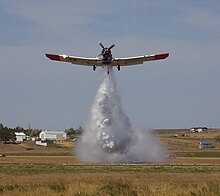



Airtankers or water bombers are fixed-wing aircraft fitted with tanks that can be filled on the ground at an air tanker base or, in the case of flying boats and amphibious aircraft, by skimming water from lakes, reservoirs, or large rivers without needing to land.
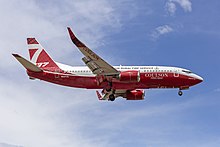
Various aircraft have been used over the years for firefighting. In 1947, the United States Air Force and United States Forest Service experimented with military aircraft dropping water-filled bombs. The bombs were unsuccessful, and the use of internal water tanks was adopted instead.[8] Though World War II- and Korean War-era bombers were for a long time the mainstay of the aerial firefighting fleet,[9] newer purpose-built tankers have since come online. The smallest are the Single Engine Air Tankers (SEATs). These are agricultural sprayers that generally drop about 800 US gallons (3,000 L) of water or retardant. Examples include the Air Tractor AT-802, which can deliver around 800 gallons of water or fire retardant solution in each drop, and the Soviet Antonov An-2 biplane. Both of these aircraft can be fitted with floats that scoop water from the surface of a body of water. Similar in configuration to the World War II–era Consolidated PBY Catalina, the Canadair CL-215 and its derivative the CL-415 are designed and built specifically for firefighting. The Croatian Air Force uses six CL-415s as well as six AT 802s for firefighting purposes.
Medium-sized modified aircraft include the Grumman S-2 Tracker (retrofitted with turboprop engines as the S-2T) as used by the California Department of Forestry and Fire Protection (CAL FIRE), as well as the Conair Firecat version developed and used by Conair Group Inc. of Canada, while the Douglas DC-4, the Douglas DC-7, the Lockheed C-130 Hercules, the Lockheed P-2 Neptune, and the Lockheed P-3 Orion – and its commercial equivalent, the L-188 Electra – have been used as air tankers. Conair also converted a number of Convair 580 and Fokker F27 Friendship turboprop airliners to air tankers.[10][11]
The largest aerial firefighter ever used is a Boeing 747 aerial firefighter, known as the Global Supertanker, that can carry 19,600 US gallons (74,200 L) fed by a pressurized drop system. The Supertanker was deployed operationally for the first time in 2009, fighting a fire in Spain.[12] The tanker made its first American operation on August 31, 2009, at the Oak Glen Fire.[13][14] It has since been replaced by a Boeing 747-400.[15] Another wide body jetliner that is currently being used as an air tanker is the modified McDonnell Douglas DC-10-30 operated by the 10 Tanker Air Carrier company as the DC-10 Air Tanker.[16] It can carry up to 12,000 US gallons (45,400 L) of fire fighting retardant.
The Russian Ministry of Emergency Situations operates convertible-to-cargo Ilyushin Il-76 airtankers that have been operating with 11,000-US-gallon (41,600 L) tanking systems, and several Beriev Be-200 jet powered amphibian aircraft. The Be-200 can carry a maximum payload of about 12,000 litres (3,200 US gal) of water, making "scoops" in suitable stretches of water in 14 seconds.
Bombardier's Dash 8 Q Series aircraft are the basis of new, next-generation air tankers. Cascade Aerospace has converted two pre-owned Q400s to act as part-time water bomber and part-time transport aircraft for France's Sécurité Civile,[17] while Neptune Aviation is converting a pre-owned Q300 as a prototype to augment its Lockheed P-2 Neptune aircraft. The Sécurité Civile also operates twelve Canadair CL-415 and nine Conair Turbo Firecat aircraft. Neptune Aviation also currently operates converted British Aerospace 146 jetliners as air tankers.[18] The BAe 146 can carry up to 3,000 gallons of fire fighting retardant. Air Spray USA Ltd. of Chico, California has also converted the BAe 146 jetliner to the role of air tanker.[19] Another modern-era passenger aircraft that has now been converted for aerial firefighting missions in the U.S. is the McDonnell Douglas MD-87 jetliner operated by Erickson Aero Tanker.[20][21] The MD-87 can carry up to 4,000 gallons of fire fighting retardant. Coulson Aviation unveiled a Boeing 737-300 firefighting conversion in May 2017. Six aircraft have been purchased from Southwest Airlines for the RADS system conversion which was planned to enter service in December 2017. The 737 aircraft is smaller than the C-130Q which allows for a wider range of airfields to be utilized. Britt Coulson further stated the aircraft will be able to retain the current seat and galley configuration for tanker operations.[22] On 22 November 2018, the 737 was used for the first time to fight a fire near Newcastle, Australia.[23]
In July 2022, Airbus tested the aerial firefighting capacity of the A400M using a roll-on/roll-off kit comprising a 20-tonne water tank and piping allowing the load to be expelled from the end of the cargo ramp.[24]
Comparison table of fixed-wing, firefighting tanker airplanes[edit]
All links, citations and data sources are listed in the paragraph above. For accident and grounding citations, see paragraph below table.
| Make and model | Country of origin | Category | Water/retardant capacity, US gallons (litres) | Notes |
|---|---|---|---|---|
| Air Tractor AT-802F | United States | Light | 807 US gal (3,050 L) | |
| Air Tractor AT-1002 | United States | Medium | 1,000 US gal (3,800 L) | |
| AN-32P Firekiller | Ukraine | Medium | 2,113 US gal (8,000 L) | |
| BAe 146 | United Kingdom | Medium | 3,000 US gal (11,000 L) | |
| Beriev Be-200 | Russia | Medium | 3,173 US gal (12,010 L) | |
| Boeing 737-300 | United States | Medium | 4,000 US gal (15,000 L) | |
| Boeing 747 Supertanker | United States | Super heavy | 19,600 US gal (74,000 L) | |
| Bombardier Dash 8 Q400-MR | Canada | Medium | 2,600 US gal (9,800 L) | |
| Canadair CL-215 | Canada | Medium | 1,300 US gal (4,900 L) | |
| Canadair CL-415 | Canada | Medium | 1,621 US gal (6,140 L) | |
| Douglas B-26 | United States | Medium | No longer in service | |
| Douglas DC-4 | United States | Medium | No longer in service | |
| Douglas DC-6 | United States | Medium | 2,800 US gal (11,000 L) | |
| Douglas DC-7 | United States | Medium | 3,000 US gal (11,000 L) | |
| Fairchild C-119 Flying Boxcar | United States | Medium | No longer in service | |
| Grumman S-2 Tracker | United States | Medium | 1,200 US gal (4,500 L) | |
| Ilyushin Il-76 | Russia | Heavy | 11,419 US gal (43,230 L) | |
| Lockheed C-130 Hercules | United States | Medium | 3,000 US gal (11,000 L) | National Guard MAFFS units |
| Lockheed C-130Q Hercules | United States | Medium | 3,500 US gal (13,000 L) | Coulson RADS-XXL |
| Lockheed L-188 Electra | United States | Medium | 3,000 US gal (11,000 L) | |
| Martin Mars | United States | Medium | 7,200 US gal (27,000 L) | |
| McDonnell Douglas DC-10-30 | United States | Heavy | 12,000 US gal (45,000 L) | |
| McDonnell Douglas MD-87 | United States | Medium | 4,000 US gal (15,000 L) | |
| North American B-25 | United States | Medium | No longer in service | |
| P-2V Neptune | United States | Medium | 2,362 US gal (8,940 L) | |
| P-3 Orion | United States | Medium | 3,000 US gal (11,000 L) | military version of the Lockheed L-188 Electra |
| PBY Catalina | United States | Medium | 1,000 US gal (3,800 L) or 1,500 US gal (5,700 L) for the Super model | |
| PZL-Mielec M-18 Dromader | Poland | Light | 570 US gal (2,200 L) | |
| ShinMaywa US-2 | Japan | Medium | 3,595 US gal (13,610 L)[25] |
Category legend: Light: under 1,000 US gallons (3,800 L), Medium: under 10,000 US gallons (38,000 L), Heavy: under 20,000 US gallons (76,000 L), Super heavy: over 20,000 US gallons (76,000 L) – currently only used for the B747 Supertanker.
Other former military aircraft utilized as firefighting air tankers in the U.S. in the past included the B-17 and the PB4Y-2, a version of the B-24.
Leadplanes[edit]
The Lead Plane function directs the activities of the airtankers by both verbal target descriptions and by physically leading the airtankers on the drop run. The leadplane is typically referred to as a "Bird Dog" in Canada or "Supervision" aircraft in Australia. The O-2 Skymaster, Cessna 310 and OV-10 Bronco have been used as spotter and lead plane platforms. The Ontario Ministry of Natural Resources has also used the Cessna 337. The Beechcraft Baron was long used as a leadplane or air attack ship, but most were retired in 2003; more common now is the Beechcraft King Air and the Twin Commander 690. A Cessna Citation 500 jet owned by Air Spray (1967) LTd. was used by the British Columbia Ministry of Forests beginning in 1995 and used for two fire seasons to lead the very fast Electra L188 air tanker to the fires. This was the first time a jet aircraft was used as a lead plane or "bird dog". The Department of Parks and Wildlife in Western Australia operates a fleet of nine American Champion Scouts 8GCBC during the summer months as spotter aircraft and Air Attack platforms. The Provinces of Alberta and British Columbia and the Yukon Territories contract to supply Twin Commander 690 as bird dog aircraft for their air tanker fleets. Air Spray owns 9 Twin Commander 690 for use as bird dog aircraft.
Fleet grounding[edit]
In the United States, most of these aircraft are privately owned and contracted to government agencies, and the National Guard and the U.S. Marines also maintain fleets of firefighting aircraft. On May 10, 2004, The U.S. Forest Service (USFS) and the Bureau of Land Management (BLM) announced that they were cancelling contracts with operators of 33 heavy airtankers. They cited liability concerns and an inability to safely manage the fleet after the wing failure and resulting crash of a C-130A Hercules in California and a PB4Y-2 in Colorado during the summer of 2002. Both aged aircraft broke up in flight due to catastrophic fatigue cracks at the wing roots. After subsequent third-party examination and extensive testing of all USFS contracted heavy airtankers, three companies were awarded contracts and now maintain a combined fleet of 23 aircraft.
Fire retardant[edit]
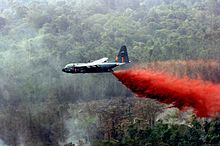
Borate salts used in the past to fight wildfires have been found to sterilize the soil and be toxic to animals so are now prohibited.[26] Newer retardants use ammonium sulfate or ammonium polyphosphate with attapulgite clay thickener or diammonium phosphate with a guar gum derivative thickener. Fire retardants often contain wetting agents, preservatives and rust inhibitors and are colored red with ferric oxide or fugitive color to mark where they have been dropped. Brand names of fire retardants for aerial application include Fortress and Phos-Chek.
Some water-dropping aircraft carry tanks of a guar gum derivative to thicken the water and reduce runoff.
Tactics and capabilities[edit]
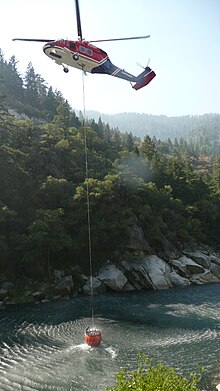
Helicopters can hover over the fire and drop water or retardant. The S-64 Helitanker has microprocessor-controlled doors on its tank. The doors are controlled based on the area to be covered and wind conditions. Fixed-wing aircraft must make a pass and drop water or retardant like a bomber. Spotter (Air Tactical Group Supervisor) aircraft often orbit the fire at a higher altitude to coordinate the efforts of the smoke jumper, helicopter, media, and retardant-dropping aircraft, while lead planes fly low-level ahead of the airtankers to mark the trajectory for the drop, and ensure overall safety for both ground-based and aerial firefighters.
Water is not usually dropped directly on flames because its effect is short-lived. Fire retardants are not typically used to extinguish the fire, but instead are used to contain the fire, or slow it down to allow ground crews to contain it. Because of this, retardants are usually dropped in front of or around a moving fire, rather than directly on it, creating a firebreak.
Aerial firefighting is most effectively used in conjunction with ground-based efforts, as aircraft are only one weapon in the firefighting arsenal. However, there have been cases of aircraft extinguishing fires long before ground crews were able to reach them.[27]
Some firefighting aircraft can refill their tanks in mid-flight, by flying down to skim the surface of large bodies of water. One example is the Bombardier CL-415. This is particularly useful in rural areas where flying back to an airbase for refills may take too much time. In 2002 an Ontario CL-415 crew was able to refill 100 times within a 4-hour mission, delivering 162,000 US gallons (613,240 L) or 1,350,000 pounds (612 t) of water on a fire near Dryden, Ontario[28] (June 1, 2002 Dryden fire # 10 Tanker #271 civil ident C-GOGE).
Accidents and incidents[edit]
- July 22, 1960: a North American B-25 Mitchell, N3446G SN 44-31466, operating as Tanker 66, impacted the earth during a water bombing run in Mill Canyon in the San Gabriel Mountains on the Magic Mountain Fire. The three crew members were killed.
- June 27, 1969: a North American B-25 Mitchell, N9088Z SN 44-30733, operating as Tanker 8Z, crash landed on a sandbar after a multi engine failure shortly after takeoff in the Tanana River, near Fairbanks Alaska. All crew members survived with no injuries. The airplane was recovered in June 2013 and is now under restoration, flying under the name "Sandbar Mitchell".[29]
- May 26, 1977: a Canadair CL-215 aircraft crashed during a training session while doing its water-taking maneuver in Greece's Eleusis Bay, killing all of its three crew members on board.[30]
- March 8, 1984: A CL-215 aircraft crashed around Greece's Eleusis bay while training was taking place. The plane crashed as it was returning to the air base after engine problems, killing all three of its crew members.[31]
- August 22, 1993 A CL-215 aircraft crashed near Patras. The aircraft's Pilot had reported that he was unable to move flight controls after water was jettisoned. The plane's crash killed 2 the crew members onboard.[32]
- August 13, 1994: a Lockheed C-130A, N135FF, operating as Tanker 82, impacted mountainous terrain near Pearblossom, California.[33] All three crew members sustained fatal injuries.[34]
- June 21, 1995: a Douglas C-54G, N4989P, operating as Tanker 19, and a Beech B58P, N156Z, operating as Lead 56 collided in mid air in Ramona, California. Two crew members of Tanker 19 as well as the pilot of Lead 56 were killed in the collision.[35][36]
- July 15, 2000: A Canadair CL-215 aircraft crashed in Greece's Pelion. The plance was prepared to to drop water when a right turn was made and a wing hit the ground, proceeding to the aircraft's explosion which killed its two crew members.[37]
- 2002 airtanker crashes: loss of Tanker 130 and Tanker 123.
- July 16, 2003: a Lockheed L188 Electra operated by Air Spray Ltd. struck the terrain on the side of a steep ridge while fighting a wildfire near Cranbrook, BC. Two pilots were killed.
- July 31, 2010: a Convair CV580 operated by Conair Aviation crashed battling a wildfire near Vancouver BC. The two pilots were killed in the crash.[38]
- May 21, 2011: a Bell 212 helicopter went down just offshore in Lesser Slave Lake, Alberta, killing the pilot.[39][40]
- June 3, 2012: a Lockheed P2V-7, operating as Tanker 11, crashed into mountainous terrain while fighting a wildfire in Utah. The 2 pilots were killed in the crash.[41]
- July 1, 2012: a Lockheed C-130 operated by the North Carolina Air National Guard's 145th Airlift Wing crashed in the Black Hills of South Dakota while supporting efforts to contain the White Draw Fire. Four airmen were killed, while two airmen survived the crash but sustained serious injuries.[42][43]
- October 24, 2013: a modified PZL-Mielec M-18A Dromader, operated by Rebel Ag crashed after the left wing separated in flight while conducting waterbombing operations west of Ulladulla, New South Wales, killing the pilot.[44]
- October 7, 2014: witness reports an S2T impacting terrain while engaging the Dog Rock Fire near Yosemite National Park California[45]
- May 22, 2015: an Air Tractor 802F Fire Boss amphibious air tanker, operated by Conair Aviation crashed battling a wildfire near Cold Lake, Alberta, killing the pilot.[46]
- July 10, 2015: an Air Tractor 802F Fire Boss amphibious air tanker, operated by Conair Aviation crashed and sank while scooping water from Puntzi Lake, British Columbia.The pilot was not injured.[47]
- 17 August 2018: a BK117 owned by Sydney Helicopters crashed after hitting a tree while supporting operations on the Kingiman fire west of Ulladulla, New South Wales, Australia, with the pilot dying.[48]
- 23 January 2020: C-130H N134CG of Coulson Aviation was destroyed when it crashed near Cooma, New South Wales during operations to fight a bushfire of the 2019–20 Australian bushfires. 3 fatalities.[49]
- 14 August 2021: A Russian Be200 plane crashed while fighting wildfires in Turkey. Eight people were on board, all of whom were killed.[50]
- 27 October 2022: Canadair CL-415 I-DPCN fire fighting plane impacted the side of a mountain near Linguaglossa in Italy immediately after dropping its load. Both pilots died in the accident.[51]
- 6 February 2023: A Boeing 737-300 N619SW of Coulson Aviation crashed in Western Australia.[52]
- 25 July 2023: A Canadair CL-215GR crashed in Greece while attempting to put out fires near Karystos killing its two crew members.[53]
In popular culture[edit]
- The CGI movie Planes: Fire & Rescue depicts aerial firefighting.
- The plot of Steven Spielberg's 1989 remake movie Always centers around aerial firefighting.
- In the 2003 direct-to-video film Rescue Heroes: The Movie, Wendy Waters, Ariel Flyer, Sam Sparks, Hal E. Copter and firefighters of the Canadian Airborne Firefighters have responded to the major forest fire in Canada.
- The 2017 movie Only the Brave depicts several instances of aerial firefighting.
See also[edit]
- Glossary of wildfire terms
- Smokejumper
- Wildfire suppression
- Modular Airborne FireFighting System
- Aerial firefighting and forestry in southern Australia
Notes[edit]
- ^ "USDA Forest Service Wildland Fire Chemicals". Retrieved 2008-11-13.
- ^ von Koenig-Warthausen, Baron F K (1930). Wings Around the World.
- ^ "FindLaw's United States Ninth Circuit case and opinions". Retrieved 19 November 2016.
- ^ Aviation Services - Aviation, Forest Fire and Emergency Services, Ontario Ministry of Natural Resources
- ^ Jump up to:a b "Interagency Standards for Fire and Aviation Operations 2007, Chapter 17" (PDF). National Interagency Fire Center. Archived from the original (PDF) on 2007-09-28. Retrieved 2007-08-31.
The popular media also frequently use the terms water bomber, fire bomber or borate bomber. Helicopters often are used to drop retardant or water on a wildfire, whether they're functioning as helitankers (a heavy helicopter outfitted with a belly tank for dropping water or retardant on a fire), or medium- or light-weight helicopters equipped with buckets for smaller drops on fires). Some helicopters are used on fires for cargo (helitack) delivering supplies to firefighters, usually with netted cargo slung under a helicopter, and other helicopters are certified for and used for personnel transport -- ferrying wildland firefighters to remote locations where ground transport is either difficult or impossible.
- ^ "Wildfire Fighting: Provincial & Territorial Approaches to Air Tankers". Canadian American Strategic Review. May 2016. Archived from the original on 2016-06-11.
- ^ "Statement of Larry Hamilton National Director, Office of Fire and Aviation, Department of the Interior, Bureau of Land Management, National Interagency Fire Center Oversight Hearing". Blue Ribbon Panel Report and Aerial Firefighting Safety Senate Energy and Natural Resources Committee Subcommittee on Public Lands and Forests. March 26, 2003. Retrieved 2007-09-27.
- ^ Hearst Magazines (October 1947). "Water Bombs for Forest Fires". Popular Mechanics. Hearst Magazines. p. 126.
- ^ "AT&T - Page Not Available". Retrieved 19 November 2016.
- ^ "Photos of Convair 580". Airliners.net. Retrieved July 26, 2017.
- ^ "Photos of Fokker F-27". Airliners.net. Retrieved July 26, 2017.
- ^ ABC - El 'superavión' bombero no fue efectivo en incendio Serranía de Cuenca (in Spanish)
- ^ "Incident Report". Rimoftheworld.Net. Archived from the original on 2009-09-02. Retrieved 2010-05-28.
- ^ "InciWeb the Incident Information System: Oak Glen". Inciweb.org. 2009-08-30. Retrieved 2010-05-28.
- ^ "Like the phoenix, the SuperTanker to rise again". Fire Aviation. 12 August 2015. Retrieved 2016-11-22.
- ^ "10 Tanker LLC". Retrieved 19 November 2016.
- ^ Q400 Airtanker Conversion
- ^ "Operations". neptuneaviation.com. Retrieved July 26, 2017.
- ^ Gabbert, Bill (2 October 2012). "Air Spray moves into California, will convert the BAe 146 jet into air tanker". Wildfire Today. Retrieved 9 January 2013.
- ^ "Erickson Aero Tanker places its first McDonnell Douglas DC-9-87 into fire tanker operations". worldairlinenews.com. Retrieved July 26, 2017.
- ^ "Air tankers could mean more jobs in Madras". Archived from the original on 2013-05-01. Retrieved 2013-07-24.
- ^ "Coulson to convert 737s into air tankers". Fire Aviation. Retrieved 2017-10-02.
- ^ "Coulson 737 waterbomber used for the first time". ABC News. Retrieved 2018-11-23.
- ^ Hoyle, Craig (26 July 2022). "A400M tests aerial firefighting adaptation with Spanish support". Flight Global.
- ^ "Infinite Possibilities of the US-2; Firefighting Amphibians". ShinMaywa. Archived from the original on January 29, 2018. Retrieved July 26, 2017.
- ^ "UDSA Forest Service Specification 5100-304c Long-Term Retardant, Wildland Firefighting" (PDF). June 1, 2007. p. 2. Archived (PDF) from the original on 8 November 2008. Retrieved 2008-11-24.
- ^ Christopher, Ben (21 July 2016). "Does Using Airplanes to Put out Forest Fires Actually Work?". Priceonomics. Retrieved 23 July 2016.
- ^ "Deceased identified after Dinorwic fire". Dryden Now. 7 November 2020.
- ^ "WARBIRDS OF GLORY B-25J SANDBAR MITCHELL RECOVERY & RESTORATION". Retrieved 27 November 2013.
- ^ "Canadair crash: Half a century of flights to Greece are closed by Canadian aircraft – Economic Post". POSTS English. Retrieved 26 July 2023.
- ^ "Canadair crash: Half a century of flights to Greece are closed by Canadian aircraft – Economic Post". POSTS English. Retrieved 26 July 2023.
- ^ "Canadair crash: Half a century of flights to Greece are closed by Canadian aircraft – Economic Post". POSTS English. Retrieved 26 July 2023.
- ^ "National Transportation Safety Board Aviation Accident Final Report Accident Number: LAX94FA323". National Transportation Safety Board. December 19, 1995. Retrieved July 26, 2017.
- ^ "27 Deaths in Air Tanker Crashes Since 1991". KOLO-TV. Retrieved 26 July 2017.
- ^ "National Transportation Safety Board Aviation Accident Final Report Accident Number: LAX95GA219A". National Transportation Safety Board. June 25, 1996. Retrieved July 26, 2017.
- ^ "National Transportation Safety Board Aviation Accident Final Report Accident Number: LAX95GA219B". National Transportation Safety Board. June 25, 1996. Retrieved July 26, 2017.
- ^ "Canadair crash: Half a century of flights to Greece are closed by Canadian aircraft – Economic Post". POSTS English. Retrieved 26 July 2023.
- ^ "Air tanker pilots killed in B.C. crash identified". CTV News Vancouver. May 18, 2012. Retrieved July 26, 2017.
- ^ "Firefighting helicopter crash in Slave Lake, one fatality". wildfiretoday.com. 21 May 2011. Retrieved 25 June 2012.
- ^ "Pilot dies in helicopter crash near Slave Lake". cbc.ca. Retrieved 25 June 2012.
- ^ Whitfield, Bethany (14 June 2012). "NTSB Issues Preliminary Air Tanker Crash Report". Flying. Retrieved 26 July 2017.
- ^ Carver, Lt. Col. Robert (3 July 2012). "ANG announces C-130 crash victims". US Air Force. Retrieved 26 July 2017.
- ^ Bailey, David (2 July 2012). "Air Force C-130 crashes fighting South Dakota wildfire". Reuters. Retrieved 26 July 2017.
- ^ "Investigation: AO-2013-187 - In-flight breakup involving PZL Mielec M18A Dromader aircraft, VH-TZJ, 37 km west of Ulladulla, NSW on 24 October 2013". Australian Transport Safety Bureau. Retrieved 2016-11-23.
- ^ Welch, William M. (8 October 2014). "Pilot of crashed plane near Yosemite fire dies". USA Today. Retrieved 26 July 2017.
- ^ Passifiume, Bryan (2015-05-22). "Pilot dead after water bomber battling wildfire near Cold Lake crashes Friday afternoon". Calgary Sun. Retrieved 2017-07-26.
- ^ Gabbert, Bill. "Air tanker crashes in British Columbia lake". Fire Aviation. Retrieved 2015-10-01.
- ^ Pilot dies in waterbombing helicopter crash on NSW south coast, ABC News Online, 2018-08-17
- ^ Bungard, Matt; Mellis, Eilidh (23 January 2020). "Three dead as air tanker fighting bushfires crashes near Snowy Mountains". The Sydney Morning Herald. Fairfax Media. Retrieved 23 January 2020.
- ^ Russia says all 8 die in water-bomber plane crash in Turkey, The Moscow Times, 2021-08-14
- ^ Ranter, Harro. "ASN Aircraft accident Canadair CL-215-6B11 (CL-415) I-DPCN Linguaglossa, Sicily". aviation-safety.net. Retrieved 2022-10-28.
- ^ "Two pilots in hospital after water bomber crashes fighting bushfire in regional WA". ABC News. 2023-02-06. Retrieved 2023-02-06.
- ^ Pitsakis, John. "BREAKING: Hellenic Air Force CL-215 Scooper Crashes in Greece". Aerial Fire Magazine.
References[edit]
- Auliard, Gilles (July 1995). "Le musée volanta des pompiers du ciel américains" [The American Flying Museum of Aerial Firefighters]. Le Fana de l'Aviation (in French) (308): 44–51. ISSN 0757-4169.
- Keijsper, Gerard. "Water-Bombers Required!" Air Forces Monthly, London: Key Publishing, July 2008 Issue.
- Marsaly, Frédéric and Prétat, Samuel. "Bombardiers d'eau Canadair Scoopers" Editions Minimonde76, May 2012, ISBN 9-782954-181806.
- Mormillo, Frank B. (March–April 1999). "Call for Fire Attack!: A 'One-two' Formation by Mars and PBY Might Still Outclass the Modern Options". Air Enthusiast (80): 5–11. ISSN 0143-5450.
- Pickler, Ron and Larry Milberry. Canadair: The First 50 Years. Toronto: CANAV Books, 1995. ISBN 0-921022-07-7.
- Roosens, Daniel & Boulay, Philippe (February 1990). "Les bombardiers d'eau français" [French Water Bombers]. Le Fana de l'Aviation (in French) (243): 6–13. ISSN 0757-4169.
